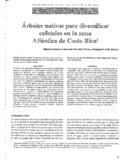Árboles nativos para diversificar cafetales en la zona Atlántica de Costa Rica
Alternative title
Native trees for the diversification of coffee farms in the Atlantic zone of Costa Rica
Description
1 ilus. 2 tab. 22 ref. 7 pág.
Abstract
El objetivo del estudio fue contribuir al desarrollo de la caficultura sostenible, identificando y caracterizando especies arbóreas que pueden ser utilizadas para diversificar cafetales de la zona Atlántica de Costa Rica. Se entrevistó a 95 caficultores para identificar las especies arbóreas utilizadas como sombra y los atributos claves que determinan la compatibilidad de los árboles con café. Los finqueros mencionaron 62 especies arbóreas, arbustivas y herbáceas (Musa spp.) que han sido utilizadas en cafetales de la zona de las cuales 40 especies fueron identificadas como "nativas" (algunas son naturalizadas). Los atributos más importantes de los árboles fueron los relacionados con el establecimiento, manejo y compatibilidad, particularmente basados en características de la copa (p.ej., forma y tamaño) y de las raíces. De las 62 especies, 16 fueron clasificadas dentro de las más adecuadas para ser asociadas con café. Entre ellas, las de mayor calificación para la zona Atlántica de Costa Rica fueron Inga spp., Psidium friedrichsthalianum, Spondias purpurea, Cordia alliodora, Cedrela odorata, Simarouba amara, Erythrina poeppigiana y Gliricidia sepium. The objective of the study was to contribute to the development of sustainable coffee production by identifying and characterizing trees that can be used to diversify coffee plantations in the Atlantic region of Costa Rica. Interviews of 95 coffee farmers were used to identify coffee shade trees and the atributes that determine the compatibility of these trees with coffee. The farmers mentioned a total of 62 tree, shrub and herbaceous (Musa spp.) species that have been used in coffee plantations in this zone of these, 40 were identified as "native" tree species (some are in fact naturalized). The most important tree attributes were those related to the establishment, management and compatibility of the trees, particularly based on crown (e.g., crown width, crown shape) and root attributes. Amongst these 62 species, 16 were classified as the most suitable for incorporation in coffee plantations. Among them, Inga spp., Psidium friedrishsthalianum, Spondias purpurea, Cordia alliodora, Cedrela odorata, Simarouba amara, Erythrina poeppigiana and Gliricidia sepium were the tree species with the highest qualifications for the Atlantic region of Costa Rica
Keywords
Publisher
CATIE, Turrialba (Costa Rica)


